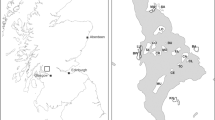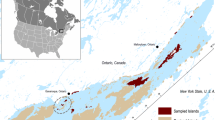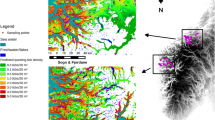Abstract
Landscape heterogeneity can be instrumental in determining local disease risk, pathogen persistence and spread. This is because different landscape features such as habitat type determine the abundance and spatial distributions of hosts and pathogen vectors. Therefore, disease prevalence and distribution are intrinsically linked to the hosts and vectors that utilise the different habitats. Here, we develop a simplified reaction diffusion model of the louping-ill virus and red grouse (Lagopus lagopus scoticus) system to investigate the occurrence of a tick-borne pathogen and the effect of host movement and landscape structure. Ticks (Ixodes ricinus), the virus-vector, are dispersed by a virally incompetent tick host, red deer (Cervus elephus), between different habitats, whilst the virus infects only red grouse. We investigated how deer movement between different habitats (forest and moorland) affected tick distribution and hence prevalence of infected ticks and grouse and hence, the effect of habitat size ratio and fragmentation on infection. When habitat type has a role in the survival of the pathogen vector, we demonstrated that habitat fragmentation can have a considerable effect on infection. These results highlight the importance of landscape heterogeneity and the proximity and size of adjacent habitats when predicting disease risk in a particular location. In addition, this model could be useful for other pathogen systems with generalist vectors and may inform policy on possible disease management strategies that incorporate host movements.





Similar content being viewed by others
References
Allan BF, Keesing F, Ostfeld RS (2003) Effect of forest fragmentation on Lyme disease risk. Conserv Biol 17:272
Boots M, Sasaki A (2001) Parasite–driven extinction in spatially explicit host–parasite systems. Am Nat 159:706–713
Caraco T, Glavanakov S, Gang C, Flaherty JE, Ohsumi TK, Szymanski BK (2002) Stage-structured infection transmission and a spatial epidemic: a model for Lyme disease. Am Nat 160:348–359
Danielova V, Holubova J, Daniel M (2002) Tick-borne encephalitis virus prevalence in Ixodes ricinus ticks collected in high risk habitats of the South-Bohemian region of the Czech Republic. Exp Appl Acarol 26:145–151
Davies KF, Melbourne BA, Margules CR (2001) Effects of within-and between-patch processes on community dynamics in a fragmentation experiment. Ecology 82:1830–1846
Delgardo S, Carmenes P (1995) Seroepidemiological survey for Borrelia burgdorferi (Lyme disease) in dogs from northwestern of Spain. Eur J Epidemiol 11:321–324
Ewers RM, Thorpe S, Didham RK (2007) Synergistic interactions between edge and area effects in a heavily fragmented landscape. Ecology 88:106
Fagan WF, Cantrell RS, Cosner C (1999) How habitat edges change species interactions. Am Nat 153:165–182
Fletcher RJ (2005) Multiple edge effects and their implication in fragmented landscapes. J Anim Ecol 74:342–352
Gilbert L, Norman R, Laurenson K, Reid HW, Hudson PJ (2001) Disease persistence and apparent competition in a three host community: an empirical and analytical study of large-scale, wild populations. J Anim Ecol 70:1053–1061
Gratz NG (1999) Emerging and resurging vector-borne diseases. Annu Rev Entomol 44:51–75
Gray JS (1998) The ecology of ticks transmitting Lyme borreliosis. Exp Appl Acarol 22:249–258
Gray JS, Lohan G (1982) The development of a sampling method for the tick Ixodes ricinus and its use in a redwater fever area. Ann Appl Biol 101:421–427
Hudson PJ (1992) Grouse in space and time: the population of managed gamebird. The Game Conservancy, Fordingbridge, Hants
Hudson PJ, Norman R, Laurenson MK, Newborn D, Gaunt M, Jones LD, Reid HW, Gould EA, Bowers R, Dobson A (1995) Persistence and transmission of tick-borne viruses: ixodes ricinus and louping ill virus in red grouse populations. Parasitology 111:49–58
Jones LD, Gaunt M, Hails RS, Laurenson K, Hudson PJ, Reid HW, Henbest P, Gould EA (1997) Transmission of Louping ill virus between infected and uninfected ticks co-feeding on mountain hares. Med Vet Entomol 11:172–176
Kalluri S, Gilruth P, Rogers D, Szczur M (2007) Surveillance of arthropod vector-borne infectious diseases using remote sensing techniques: a review. PLoS Pathog 3:1361–1371
Kirby AD, Smith AA, Benton TG, Hudson PJ (2004) Rising burden of immature sheep ticks (Ixodes ricinus) on red grouse (Lagopus lagopus scoticus) chicks in the Scottish uplands. Med Vet Entomol 18(1):67–70
Kivaria FM (2006) Estimated direct economic costs associated with tick-borne diseases on cattle in Tanzania. Trop Anim Health Prod 38:291–299
Laurenson MK, Norman R, Gilbert L, Reid HW, Hudson PJ (2003) Identifying disease reservoirs in complex systems: mountain hares as reservoirs of ticks and louping-ill virus, pathogens of red grouse. J Anim Ecol 72:177–185
Malcolm JR (1994) Edge effects in central amazonian forest fragments. Ecology 75:2438–2445
Maupin G, Fish D, Zultowsky J, Campos EG, Piesman J (1991) Landscape ecology of lyme disease in a residential area of Westcheter County, New York. Am J Epidemiol 133:1105–1113
McCallum H (2008) Landscape structure, disturbance, and disease dynamics. In: Ostfeld FR (ed) Infectious disease ecology: effects of ecosystems on disease and of disease on ecosystems. Princeton University Press, Princeton
Norman R, Bowers RG, Begon M, Hudson PJ (1999) Persistence of tick-borne virus in the presence of multiple host species: tick reservoirs and parasite mediated competition. J Theor Biol 200:111–118
Nupp TE, Swihart RK (1996) Effect of forest patch area on population attributes of white-footed mice (Peromyscus leucopus) in fragmented landscapes. Can J Zool 74:467–472
Ostfeld RS, Cepeda OM, Hazler KR, Miller MC (1995) Ecology of Lyme disease: habitat associations of ticks (Ixodes scapularis) in a rural landscape. Ecol Appl 5:353–361
Ostfeld RS, Hazler KR, Cepeda OM (1996) Temporal and spatial dynamics of Ixodes scapularis (Acari: Ixodidae) in a rural landscape. J Med Entomol 33:90–95
Parola P, Raoult D (2001) Tick-borne bacterial diseases emerging in Europe. Clin Microbiol Infect 7:80–83
Patrick CD, Hair JA (1978) White-tailed deer utilization of three different habitats and its influence on lone star tick populations. J Parasitol 64:1100–1106
Petrovec M, Lotric Furlan S, Zupanc TA, Strle F, Brouqui P, Roux V, Dumler JS (1997) Human disease in Europe caused by a granulocytic Ehrlichia species. J Clin Microbiol 35:1556–1559
Power AG, Mitchell CE (2004) Pathogen spillover in disease epidemics. Am Nat 164:79–89
Rand DA, Keeling MJ, Wilson HB (1995) Invasion, stability and evolution to criticality in spatially extended artificial host–pathogen ecologies. Proc R Soc Lond B Biol Sci 259:55–63
Randolf SE (2008) Tick-borne encephalitis incidence in Central and Eastern Europe: consequences of political transition. Microbes Infect 10:209–216
Randolf SE, Green RM, Hoodless AN, Peacey MF (2002) An empirical framework for seasonal population dynamics of the tick Ixodes ricinus. Int J Parasitol 31:979–989
Reid HW (1975) Experimental infection of the red grouse with Louping-ill virus (Flavivirus group) viraemia antibody response. J or Comp Pathol 85:231–235
Reid HW (1984) Epidemiology of louping-ill. In: Mayo MA, Harrap KH (eds) Tick Vectors in Virus Biology. Academic, New York, pp 161–178
Reid HW, Duncan JS, Phillips JDP, Moss R, Watson A (1978) Studies of Louping-ill virus (Flavivirus group) in wild red grouse (Lagopus lagopus scoticus). J Hyg 81:321–329
Sachs JM (2002) The economic and social burden of malaria. Nature 415:680–685
Sato K, Matsuda H, Sasaki A (1994) Pathogen invasion and host extinction in lattice structured populations. J Math Biol 32:251–268
Tisdell CA, Harrison SR, Ramsay GC (1999) The economic impacts of endemic diseases and disease control programmes. Rev Sci Tech 18:380–389
Van Buskirk J, Ostfeld RS (1998) Habitat heterogeneity, dispersal, and local risk of exposure to Lyme disease. Ecol Appl 8:365–378
Vassallo M, Paul REL, Perez-Ei (2000) Temporal distribution of the annual nymphal stock of Ixodes ricinus ticks. Experimental and Applied Acarology 24:941–949
Webb SD, Keeling MJ, Boots M (2007) Host–parasite interactions between the local and the mean-field: how and when does spatial population structure matter? J Theor Biol 249:140–152
Woolhouse MEJ, Taylor LH, Haydon DT (2001) Population biology of multi-host pathogens. Science 292:1109–1112
Acknowledgements
This work is funded by an Epidemiology, Population Health & Infectious Disease Control (EPIC) Centre of Excellence fellowship supported by the Scottish government, and supported and housed at the Macaulay Land Use and Research Institute (MLURI). We appreciate Dr J Booth for aiding the completion of the manuscript.
Author information
Authors and Affiliations
Corresponding author
Appendix: Derivation of equations
Appendix: Derivation of equations
We will now describe how we attained the system equations.
Grouse and corresponding (attached) tick Eqs. 15–21
Let \( G_\sigma^j\left( {x,t} \right) \) be the density of grouse with j ticks, where σ ∊ {S, I} and \( 0 \leqslant j \leqslant N \). Let \( G_R^{j,i}\left( {x,t} \right) \) be the density of recovered grouse with j susceptible and i infected ticks, respectively. We define the following
Equations describing the evolution of \( G_s^0\left( {x,t} \right) \) and \( G_I^0\left( {x,t} \right) \) over time can be written as
where we assume that all grouse can reproduce and each newborn is susceptible and has no ticks. Now, for \( N - 1 \geqslant j \geqslant 1 \), we have
and for j = N
Summing over 0 ≤ j ≤ N then gives the following
Note that for the derivation of (22), we have used the following:
That is, we have assumed that N is sufficiently large that the corresponding density \( G_s^N \) is small and can, therefore, be neglected to leading order. We define the following quantities
to be the average number of (attached) ticks per susceptible and infected grouse, respectively. Rearranging gives
Differentiating with respect to time then gives
which, upon substituting (21) and (15), (17), (19), yields
and, using (22) and (16), (18), (20),
Now differentiating the expressions in (23) twice with respect to x gives
Substitution into (24) and using (23) then simplifies (24), after a little re-arranging, to
The rationale behind the unattachment of ticks is that each individual tick has a mean feeding time of 1/μg and the rate of detachment will be the inverse of this value. Therefore, if there are j ticks on the host, then total rate of detachment will be j times this value, namely, jμg.
Similarly, (25) becomes
Note that we have again used the assumption that \( G_s^N \) is small, so that \( \sum\nolimits_{j = 0}^{N - 1} {G_s^j} \) approximates to G s .
The equation for G R can be derived in a similar way. Namely, we have:
for 1 ≤ i ≤ N−1,
for 1 ≤ j ≤ N−1,
for 1 ≤ i ≤ N-1,
for 1 ≤ j ≤ N−1,
for 1 ≤ j,i ≤N −1,
Summing over 0 ≤ j,i ≤ N then gives
We define the following quantities
to be the average number of (attached) susceptible and infected ticks per recovered grouse, respectively. Rearranging gives
Differentiating these expressions give
Substituting (37) and (28) to (36) into (39) then yields, after a little re-arranging
Substituting (41), we then obtain
assuming, similar to above, that N is sufficiently large so that \( \sum\nolimits_{i = 0}^N {\sum\nolimits_{j = 0}^{N - 1} {G_R^{j,i} \approx {G_R}} } \). Similarly, substituting (37) and (28) to (36) into (40) and using (42), we get
and
assuming that \( \sum\nolimits_{j = 0}^N {\sum\nolimits_{i = 0}^{N - 1} {G_R^{j,i} \approx {G_R}} } \).
Deer Eqs. 22–23
Let D j (x, t) be the density of deer with j ticks, 0 ≤ j ≤ N. Note that attached ticks can be either susceptible or infected. Note also that, in this case, we also assume density dependence on tick uptake. Specifically, we assume that the uptake rate, β D , is given by
That is, uptake rate decreases monotonically as the number of already attached ticks increases, representing a limit of tick occupancy space on the deer. We take \( {\beta_D}\left( {j > N} \right) = 0 \).
An equation describing the evolution of \( {D^0}\left( {x,t} \right) \) over time can be written as
where \( D = \sum\nolimits_{j = 0}^N {{D^j}} \) and we assume, as for grouse, a logistic growth rate for deer and with each newborn having no ticks. For \( N - 1 \geqslant j \geqslant 1 \), we have
and for j=N
Summing over \( 0 \leqslant j \leqslant N \) gives the following
Similar to before, we define
to be the average number of (attached) ticks per deer, so that
Differentiating then gives
and
which, upon substituting (50) and (47) to (51), yields
which simplifies to
Questing tick Eqs. 24–25
Summing the uptake and drop-off terms from above gives the following
Note that we have additionally assumed a linear death term for ticks, with constant rate b T and a proliferative rate ρ t as the ticks drop-off deer (taking the newborn ticks to be susceptible).
From (54), again taking for simplicity \( \sum\nolimits_{j = 0}^{N - 1} {G_s^j \approx {G_s}} \), \( \sum\nolimits_{j = 0}^{N - 1} {G_I^j \approx {G_I}} \), \( \sum\nolimits_{j = 0}^{N - 1} {\sum\nolimits_{i = 0}^N {G_R^{j,i} \approx {G_R}} } \), we obtain the leading order expression
Similarly, we can write
where α T denotes the rate of tick virulence due to infection. Simplifying, gives to leading order
Rights and permissions
About this article
Cite this article
Jones, E.O., Webb, S.D., Ruiz-Fons, F.J. et al. The effect of landscape heterogeneity and host movement on a tick-borne pathogen. Theor Ecol 4, 435–448 (2011). https://doi.org/10.1007/s12080-010-0087-8
Received:
Accepted:
Published:
Issue Date:
DOI: https://doi.org/10.1007/s12080-010-0087-8




